An official website of the United States government
 United States Department of Labor
United States Department of Labor
Build stone structures, such as piers, walls, and abutments. Lay walks, curbstones, or special types of masonry for vats, tanks, and floors.
Employment estimate and mean wage estimates for Stonemasons:
| Employment (1) | Employment RSE (3) |
Mean hourly wage |
Mean annual wage (2) |
Wage RSE (3) |
|---|---|---|---|---|
| 9,790 | 5.7 % | $ 27.37 | $ 56,930 | 1.6 % |
Percentile wage estimates for Stonemasons:
| Percentile | 10% | 25% | 50% (Median) |
75% | 90% |
|---|---|---|---|---|---|
| Hourly Wage | $ 17.56 | $ 22.09 | $ 24.92 | $ 31.11 | $ 38.87 |
| Annual Wage (2) | $ 36,530 | $ 45,940 | $ 51,830 | $ 64,700 | $ 80,850 |
Industries with the highest published employment and wages for Stonemasons are provided. For a list of all industries with employment in Stonemasons, see the Create Customized Tables function.
Industries with the highest levels of employment in Stonemasons:
| Industry | Employment (1) | Percent of industry employment | Hourly mean wage | Annual mean wage (2) |
|---|---|---|---|---|
| Foundation, Structure, and Building Exterior Contractors | 5,130 | 0.52 | $ 29.12 | $ 60,570 |
| Nonmetallic Mineral Product Manufacturing | 1,420 | 0.34 | $ 23.13 | $ 48,120 |
| Residential Building Construction | 1,030 | 0.11 | $ 27.60 | $ 57,400 |
| Building Finishing Contractors | 810 | 0.10 | $ 24.37 | $ 50,690 |
| Other Specialty Trade Contractors | 320 | 0.04 | (8) | (8) |
Industries with the highest concentration of employment in Stonemasons:
| Industry | Employment (1) | Percent of industry employment | Hourly mean wage | Annual mean wage (2) |
|---|---|---|---|---|
| Foundation, Structure, and Building Exterior Contractors | 5,130 | 0.52 | $ 29.12 | $ 60,570 |
| Nonmetallic Mineral Product Manufacturing | 1,420 | 0.34 | $ 23.13 | $ 48,120 |
| Residential Building Construction | 1,030 | 0.11 | $ 27.60 | $ 57,400 |
| Building Finishing Contractors | 810 | 0.10 | $ 24.37 | $ 50,690 |
| Other Specialty Trade Contractors | 320 | 0.04 | (8) | (8) |
Top paying industries for Stonemasons:
| Industry | Employment (1) | Percent of industry employment | Hourly mean wage | Annual mean wage (2) |
|---|---|---|---|---|
| Nonresidential Building Construction | 190 | 0.02 | $ 36.42 | $ 75,750 |
| Foundation, Structure, and Building Exterior Contractors | 5,130 | 0.52 | $ 29.12 | $ 60,570 |
| Residential Building Construction | 1,030 | 0.11 | $ 27.60 | $ 57,400 |
| Employment Services | 90 | (7) | $ 26.24 | $ 54,570 |
| Services to Buildings and Dwellings | (8) | (8) | $ 25.84 | $ 53,750 |
States and areas with the highest published employment, location quotients, and wages for Stonemasons are provided. For a list of all areas with employment in Stonemasons, see the Create Customized Tables function.
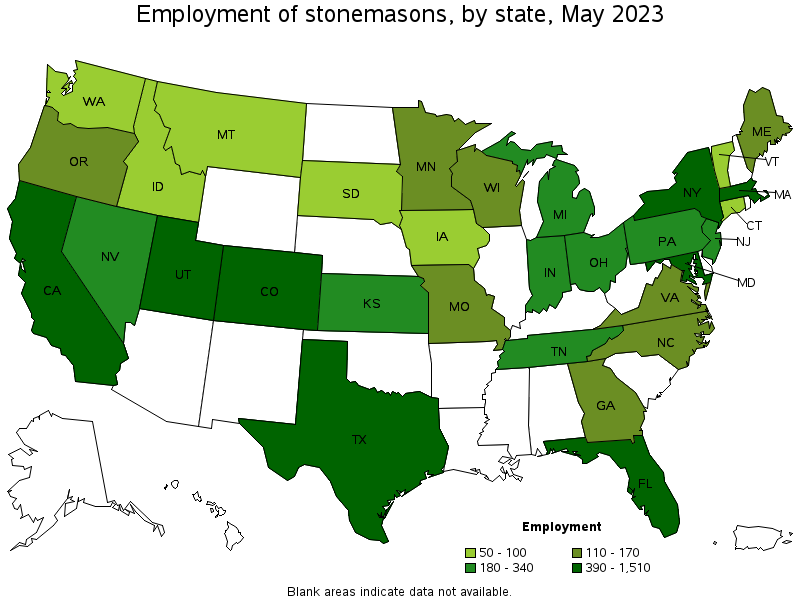
States with the highest employment level in Stonemasons:
| State | Employment (1) | Employment per thousand jobs | Location quotient (9) | Hourly mean wage | Annual mean wage (2) |
|---|---|---|---|---|---|
| California | 1,510 | 0.08 | 1.30 | $ 30.74 | $ 63,930 |
| Massachusetts | 1,040 | 0.29 | 4.43 | $ 29.45 | $ 61,250 |
| Maryland | 810 | 0.30 | 4.67 | $ 22.76 | $ 47,330 |
| New York | 790 | 0.08 | 1.30 | $ 36.05 | $ 74,980 |
| Florida | 430 | 0.04 | 0.69 | $ 23.29 | $ 48,450 |
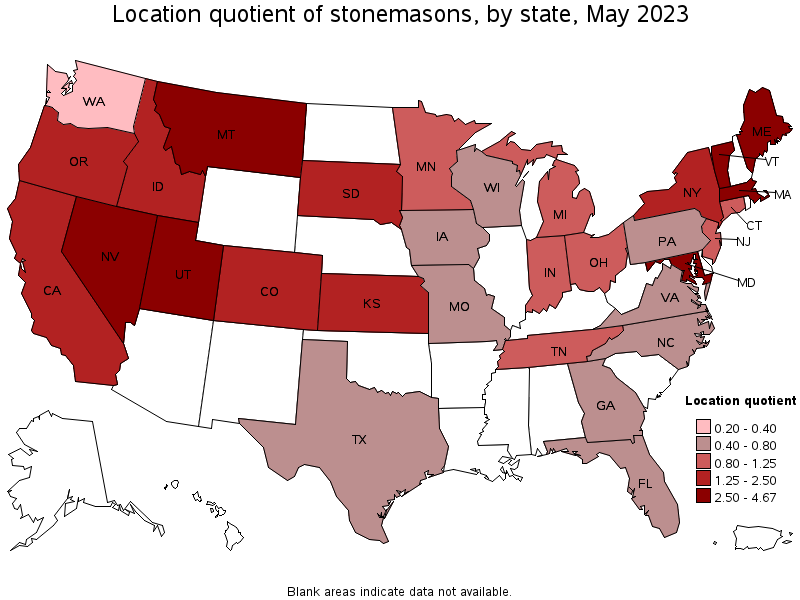
States with the highest concentration of jobs and location quotients in Stonemasons:
| State | Employment (1) | Employment per thousand jobs | Location quotient (9) | Hourly mean wage | Annual mean wage (2) |
|---|---|---|---|---|---|
| Maryland | 810 | 0.30 | 4.67 | $ 22.76 | $ 47,330 |
| Massachusetts | 1,040 | 0.29 | 4.43 | $ 29.45 | $ 61,250 |
| Maine | 170 | 0.27 | 4.18 | $ 25.58 | $ 53,210 |
| Utah | 400 | 0.24 | 3.74 | $ 26.55 | $ 55,230 |
| Vermont | 70 | 0.22 | 3.45 | $ 30.30 | $ 63,020 |

Top paying states for Stonemasons:
| State | Employment (1) | Employment per thousand jobs | Location quotient (9) | Hourly mean wage | Annual mean wage (2) |
|---|---|---|---|---|---|
| New Jersey | 260 | 0.06 | 0.96 | $ 36.44 | $ 75,800 |
| New York | 790 | 0.08 | 1.30 | $ 36.05 | $ 74,980 |
| Washington | 50 | 0.01 | 0.22 | $ 35.09 | $ 72,980 |
| Minnesota | 160 | 0.06 | 0.89 | $ 34.59 | $ 71,940 |
| Montana | 80 | 0.16 | 2.52 | $ 31.35 | $ 65,220 |
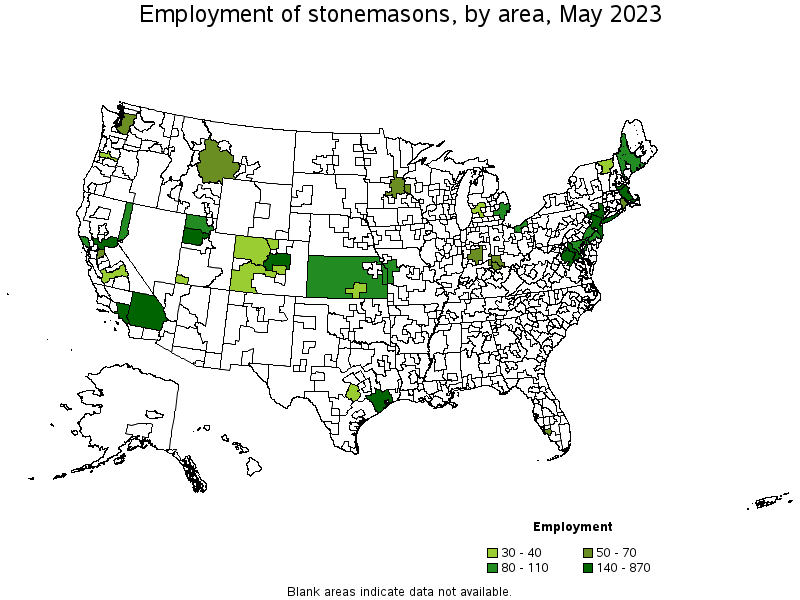
Metropolitan areas with the highest employment level in Stonemasons:
| Metropolitan area | Employment (1) | Employment per thousand jobs | Location quotient (9) | Hourly mean wage | Annual mean wage (2) |
|---|---|---|---|---|---|
| New York-Newark-Jersey City, NY-NJ-PA | 870 | 0.09 | 1.42 | $ 36.56 | $ 76,040 |
| Washington-Arlington-Alexandria, DC-VA-MD-WV | 770 | 0.25 | 3.85 | $ 23.76 | $ 49,410 |
| Boston-Cambridge-Nashua, MA-NH | 510 | 0.19 | 2.89 | $ 30.82 | $ 64,100 |
| Los Angeles-Long Beach-Anaheim, CA | 320 | 0.05 | 0.81 | $ 29.00 | $ 60,320 |
| Riverside-San Bernardino-Ontario, CA | 240 | 0.15 | 2.25 | $ 27.94 | $ 58,120 |
| Denver-Aurora-Lakewood, CO | 220 | 0.14 | 2.18 | $ 27.84 | $ 57,900 |
| Sacramento--Roseville--Arden-Arcade, CA | 220 | 0.21 | 3.24 | $ 30.23 | $ 62,880 |
| Salt Lake City, UT | 160 | 0.20 | 3.06 | $ 24.68 | $ 51,330 |
| Barnstable Town, MA | 150 | 1.51 | 23.39 | $ 27.90 | $ 58,040 |
| Houston-The Woodlands-Sugar Land, TX | 140 | 0.04 | 0.68 | $ 17.85 | $ 37,140 |
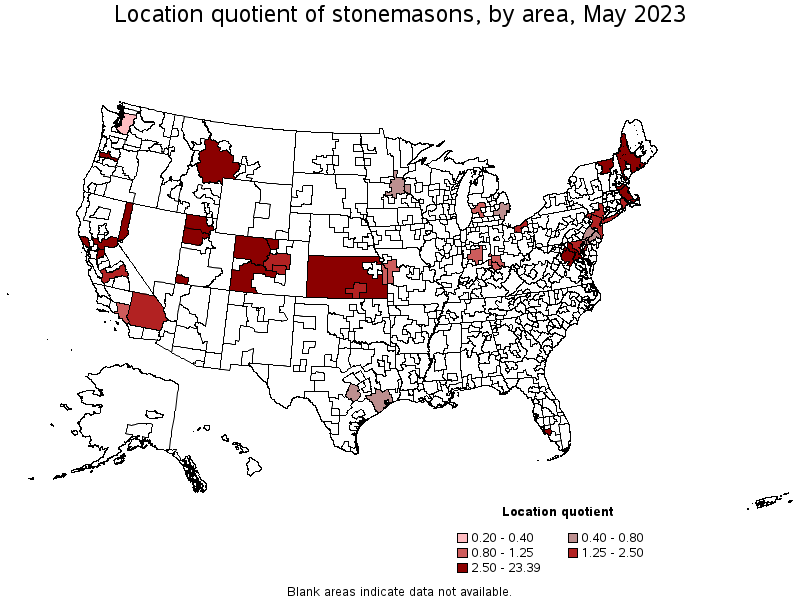
Metropolitan areas with the highest concentration of jobs and location quotients in Stonemasons:
| Metropolitan area | Employment (1) | Employment per thousand jobs | Location quotient (9) | Hourly mean wage | Annual mean wage (2) |
|---|---|---|---|---|---|
| Barnstable Town, MA | 150 | 1.51 | 23.39 | $ 27.90 | $ 58,040 |
| St. George, UT | 40 | 0.53 | 8.17 | $ 26.10 | $ 54,290 |
| Santa Rosa, CA | 90 | 0.44 | 6.88 | $ 42.27 | $ 87,930 |
| Reno, NV | 90 | 0.36 | 5.52 | $ 25.96 | $ 54,000 |
| Ogden-Clearfield, UT | 80 | 0.26 | 4.07 | $ 25.69 | $ 53,430 |
| Washington-Arlington-Alexandria, DC-VA-MD-WV | 770 | 0.25 | 3.85 | $ 23.76 | $ 49,410 |
| Salem, OR | 40 | 0.24 | 3.76 | (8) | (8) |
| Fort Collins, CO | 40 | 0.24 | 3.70 | $ 23.46 | $ 48,790 |
| Stockton-Lodi, CA | 70 | 0.24 | 3.68 | $ 30.02 | $ 62,450 |
| Sacramento--Roseville--Arden-Arcade, CA | 220 | 0.21 | 3.24 | $ 30.23 | $ 62,880 |
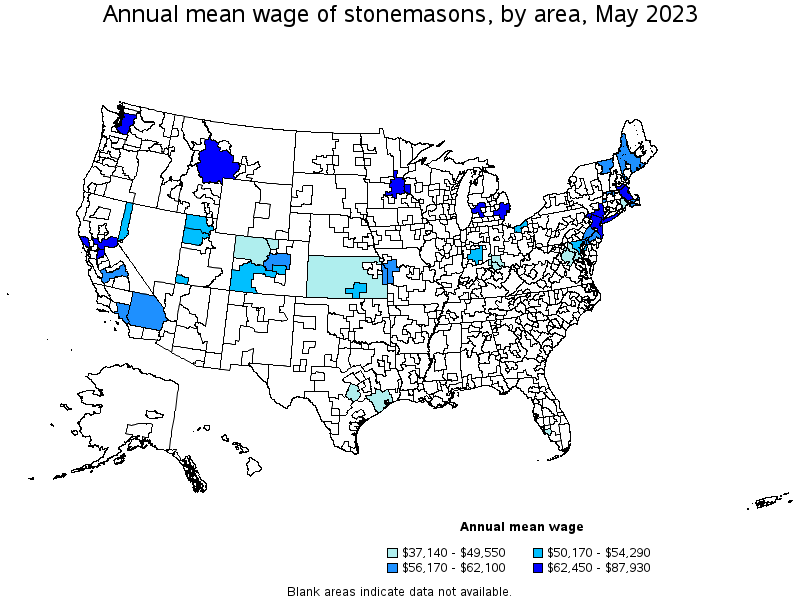
Top paying metropolitan areas for Stonemasons:
| Metropolitan area | Employment (1) | Employment per thousand jobs | Location quotient (9) | Hourly mean wage | Annual mean wage (2) |
|---|---|---|---|---|---|
| Santa Rosa, CA | 90 | 0.44 | 6.88 | $ 42.27 | $ 87,930 |
| Minneapolis-St. Paul-Bloomington, MN-WI | 70 | 0.04 | 0.56 | $ 37.60 | $ 78,200 |
| New York-Newark-Jersey City, NY-NJ-PA | 870 | 0.09 | 1.42 | $ 36.56 | $ 76,040 |
| Seattle-Tacoma-Bellevue, WA | 50 | 0.02 | 0.34 | $ 36.12 | $ 75,120 |
| Boston-Cambridge-Nashua, MA-NH | 510 | 0.19 | 2.89 | $ 30.82 | $ 64,100 |
| Detroit-Warren-Dearborn, MI | 100 | 0.05 | 0.79 | $ 30.52 | $ 63,470 |
| Grand Rapids-Wyoming, MI | 30 | 0.06 | 1.00 | $ 30.48 | $ 63,400 |
| Sacramento--Roseville--Arden-Arcade, CA | 220 | 0.21 | 3.24 | $ 30.23 | $ 62,880 |
| Stockton-Lodi, CA | 70 | 0.24 | 3.68 | $ 30.02 | $ 62,450 |
| Los Angeles-Long Beach-Anaheim, CA | 320 | 0.05 | 0.81 | $ 29.00 | $ 60,320 |
Nonmetropolitan areas with the highest employment in Stonemasons:
| Nonmetropolitan area | Employment (1) | Employment per thousand jobs | Location quotient (9) | Hourly mean wage | Annual mean wage (2) |
|---|---|---|---|---|---|
| Kansas nonmetropolitan area | 100 | 0.25 | 3.82 | $ 19.00 | $ 39,520 |
| Southwest Maine nonmetropolitan area | 90 | 0.49 | 7.63 | $ 27.26 | $ 56,690 |
| Southwest Montana nonmetropolitan area | 50 | 0.34 | 5.24 | $ 30.13 | $ 62,680 |
| Southwest Colorado nonmetropolitan area | 40 | 0.44 | 6.76 | $ 25.37 | $ 52,760 |
| Northwest Colorado nonmetropolitan area | 40 | 0.33 | 5.16 | $ 23.82 | $ 49,540 |
Nonmetropolitan areas with the highest concentration of jobs and location quotients in Stonemasons:
| Nonmetropolitan area | Employment (1) | Employment per thousand jobs | Location quotient (9) | Hourly mean wage | Annual mean wage (2) |
|---|---|---|---|---|---|
| Northern Vermont nonmetropolitan area | 40 | 0.60 | 9.34 | $ 29.86 | $ 62,100 |
| Southwest Maine nonmetropolitan area | 90 | 0.49 | 7.63 | $ 27.26 | $ 56,690 |
| Southwest Colorado nonmetropolitan area | 40 | 0.44 | 6.76 | $ 25.37 | $ 52,760 |
| Southwest Montana nonmetropolitan area | 50 | 0.34 | 5.24 | $ 30.13 | $ 62,680 |
| Northwest Colorado nonmetropolitan area | 40 | 0.33 | 5.16 | $ 23.82 | $ 49,540 |
Top paying nonmetropolitan areas for Stonemasons:
| Nonmetropolitan area | Employment (1) | Employment per thousand jobs | Location quotient (9) | Hourly mean wage | Annual mean wage (2) |
|---|---|---|---|---|---|
| Southwest Montana nonmetropolitan area | 50 | 0.34 | 5.24 | $ 30.13 | $ 62,680 |
| Northern Vermont nonmetropolitan area | 40 | 0.60 | 9.34 | $ 29.86 | $ 62,100 |
| Massachusetts nonmetropolitan area | (8) | (8) | (8) | $ 27.59 | $ 57,390 |
| Southwest Maine nonmetropolitan area | 90 | 0.49 | 7.63 | $ 27.26 | $ 56,690 |
| Southwest Colorado nonmetropolitan area | 40 | 0.44 | 6.76 | $ 25.37 | $ 52,760 |
These estimates are calculated with data collected from employers in all industry sectors, all metropolitan and nonmetropolitan areas, and all states and the District of Columbia. The top employment and wage figures are provided above. The complete list is available in the downloadable XLS files.
The percentile wage estimate is the value of a wage below which a certain percent of workers fall. The median wage is the 50th percentile wage estimate—50 percent of workers earn less than the median and 50 percent of workers earn more than the median. More about percentile wages.
(1) Estimates for detailed occupations do not sum to the totals because the totals include occupations not shown separately. Estimates do not include self-employed workers.
(2) Annual wages have been calculated by multiplying the hourly mean wage by a "year-round, full-time" hours figure of 2,080 hours; for those occupations where there is not an hourly wage published, the annual wage has been directly calculated from the reported survey data.
(3) The relative standard error (RSE) is a measure of the reliability of a survey statistic. The smaller the relative standard error, the more precise the estimate.
(7) The value is less than .005 percent of industry employment.
(8) Estimate not released.
(9) The location quotient is the ratio of the area concentration of occupational employment to the national average concentration. A location quotient greater than one indicates the occupation has a higher share of employment than average, and a location quotient less than one indicates the occupation is less prevalent in the area than average.
Other OEWS estimates and related information:
May 2023 National Occupational Employment and Wage Estimates
May 2023 State Occupational Employment and Wage Estimates
May 2023 Metropolitan and Nonmetropolitan Area Occupational Employment and Wage Estimates
May 2023 National Industry-Specific Occupational Employment and Wage Estimates
Last Modified Date: April 3, 2024